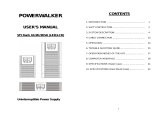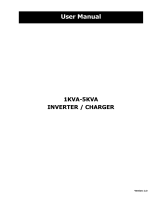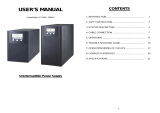Page is loading ...

USER’S MANUAL
On-Line 500VA-1KVA
DIN RAIL UPS

Contents
1. Introduction ................................................…….........
1
2. Safety instruction ......................……...……..…….…....
2
3. UPS description ...............................……..……...….....
4
4. Cable connection ....................………......…….......…...
8
5. UPS operation ............................................……...........
9
6. Trouble shooting guide .......................…………….....…
10
7. Operation modes .........……. .........…….......……..........
12
8. Specification ...........................……................................
14

1
1. Introduction
1.1 General description
The continuity of electrical power is an essential requirement for critical load
operations .The Uninterruptible Power System (UPS) is designed to meet the
user‘s need for the distribution box of important equipment. For example: PLC,
and battery switch. To choose the UPS as your equipment protector is a wise
investment because it supplies reliable, pure and stable power at affordable
price.
1.2 Key features
1. It is high frequency based full bridge true sine wave UPS
2. Built-in Lead-Acid battery (or Lithium-ion battery) and external battery
terminal
3. RS-485 communication interface
4. It can support inductive and any other different loads.
5. Light weight and compact size are easy transport and place.
1.3 Important notices
To be sure that the UPS will be operated correctly, the following items should
be noticed:
1. Read instructions carefully before operating the UPS.
2. UPS power connect instruction should be followed.
3. Please don‘t open the case to prevent danger.
4. If the UPS will be stored for long period, the battery must be charged once
every 90 days.
5. Retain the load within the rating of UPS to prevent faults.
6. Handle unusual events according to the trouble-shooting guide.
7. Keep the UPS clean and dry.

2
2. Safety instruction
2.1 Transporting
1. Disconnect all power cables if necessary.
2. Be carefully not to damage the UPS while transporting.
3. Don‘t move the UPS upside down.
4. Please transport the UPS system only in the original packaging (to protect
against shock and impact).
2.2 Positioning
1 .Do not put the UPS on rugged or declined surface.
2. Do not install the UPS system near water or in damp environments.
3. Do not install the UPS system where it would be exposed to direct sunlight
or near heat.
4. Do not block off ventilation openings in the UPS system’s housing and don’t
leave objects on the top of the UPS.
5. Allow a minimum distance of 10 cm in the rear and two sides of the UPS for
ventilation.
6. Keep the UPS far away from heat emitting sources.
7. Do not expose it to corrosive gas.
8. Ambient temperature : 0℃ - 40℃
2.3 Installation
1. The UPS must be connected to distribution box which have the earthed
shockproof and the protection against electric current.
2. Do not connect the secondary power equipment in distribution box to the
UPS.

3
2.4 Operation
1. The UPS has its own internal power source (batteries). The output terminals
may be live even when the UPS is not connected to the AC supply.
2. Ensure that no fluids or other foreign objects can enter the UPS system.
2.5 Maintenance and service
1. Caution - risk of electric shock.
Even after the UPS is disconnected from the mains power supply,
components inside the UPS system are still connected to the battery and are
still electrically live and dangerous. Before carrying out any kind of servicing
and/or maintenance, disconnect the batteries and verify that no voltage is
present.
2. Only persons adequately familiar with UPS and with the required
precautionary measures may exchange batteries and supervise operations.
Any unauthorized persons do not open cover for maintenance.
3. The UPS with high voltage may cause electric shock and have a high
short-circuit current. Please take the precautionary measures specified below
and any other measures necessary when maintenance the UPS:
- remove wristwatches, rings and other metal objects
- use only tools with insulated tools and insulated gloves.

4
3. UPS description
3.1 DIN RAIL UPS ( LED , 500VA/1KVA)
1. Plug AC power: To indicate the AC power is applied to the UPS input
( AC output is available at this time). Green LED flashing, but without
alarm sound (beep).
Battery LED : Green LED flashing and the alarm sounds(beeps). The
buzzer stops alarm sounds (beeps) after alarm sounds 7 times
2. Power (on): Press Power (on/off) button at least 3 seconds, the UPS will
start up after two beeps and green LED lights up to finish startup
procedure.
3. Power (off): Press Power (on/off) button at least 3 seconds under operation
mode, the UPS will shut down after two beeps and put out the LED, then
the LED light flashes to finish shutdown procedure.

5
3.2 Outline ( 500VA / 1KVA )

6
3.3 Case view description (500VA / 1KVA )
1. LED
5. Terminal block
(input/output)
2. Power (on/off) button 6. Breaker
3. RS-485 port 7. Fan
4. Emergency power off (optional) 8. Hander

7
3.4 Casing back view description (500VA / 1KVA )
9. Rail (no supply)
Terminal block
10. Input GND (Ground) 13. Output L (Line)
11. Input N (Neutral) 14. Output N (Neutral)
12. Input L (Line) 15. Output GND (Ground)

8
4. Cable connection
4.1 Inspection
1. The UPS may be installed and wired only by qualified electricians in
accordance with applicable safety regulations.
2. When installing the electrical wiring, please note the nominal amperage of
your incoming feeder.
3. Inspect the packaging carton and its contents for damage. Please inform
the supplier should you find signs of damage.
4.2 Connection
1. UPS input and output connection
Connect AC input wires and wires of load to terminal block of the UPS.
(About the terminal block, please refer to page 7)

9
5. UPS operation
5.1 Check prior to start up
1. Ensure the UPS is in a suitable positioning.
2. Check input cord is secured.
3. Make sure the load is disconnected or in the “OFF” position.
4. Check if input voltage meets the UPS rating required.
5.2 Operation procedure
Please follow the instructions below for the UPS operation.
1. Once the AC source is connected, the LED is flashing immediately to
indicate charging (AC output exits). LED is blinking if the AC source is
abnormal.
2 . By pressing the Power (on/off) button at least 3 seconds until the buzzer
beeps twice, the UPS will start up and LED lights up to finish startup
procedure and the UPS is under Line mode.
5.3 Storage instruction
Disconnect input power in rear panel if you will not use it for long period. If the
UPS is stored over 3 months, please keep supplying power to the UPS for at
least 24 hours to ensure battery fully recharged.

10
6. Trouble shooting guide
6.1 The following guideline may be helpful for basic problem solving
No. UPS Status Action
1
AC source is normal, but the UPS
can’t start successfully.
LED is flashing once every 2
seconds, but without buzzing.
Please check if turn on
the UPS successfully.
2
AC source is normal, but the UPS
is overload up to 110%.
LED is flashing and
alarm sound
(beeps)
once every 0.4 seconds.
LED put out the light after 15
Seconds and the
alarm sound
(beeps)
continuously.
Please reduce the load to
<100%.
3
AC source is normal, but the UPS
is overload up to 120%.
LED put out the light and the alarm
s
ounds (beeps) immediately.
Please reduce the load to
<100%.

11
4
AC source fails. The load is
supplied by battery power.
LED is flashing once every 2
seconds and the alarm sound
(beeps) once every
2.5 seconds. The alarm sound
stops beeping after 7 times.
If AC source fails, reduce
the load in order to
extend backup time. If it
is not abnormal power
failure, please check the
rated input voltage or
connected line.
5
AC source fails. The UPS is under
battery mode and battery power is
approaching low level. The LED is
flashing and buzzing once every 0.4
seconds.
The UPS will shut down
automatically. Please
save data soon.
6
AC source fails and battery runs
out. The UPS has shut down
automatically.
The UPS will restart up
when AC source is
restored. If AC source
failure is more than 6
hours, please follow
storage instruction.

12
7. Operation modes
7.1 UPS system block diagram
7.2 Normal operation
There are two main loops when AC power is normal: the AC loop and the
battery charging loop. The AC output power comes from AC power input and
passes through output replay to support power to load. The battery charging
voltage comes from AC power input and converted by AC/DC charger to
support battery-charging power.

13
7.3 AC source failure
The AC output comes from battery, passing through DC/AC inverter and static
switch within the battery backup time.

14
8. Specification
Model
RP-DRS500
RP-DRS1000
Capacity
500VA / 300W
1KVA / 500W
Input
Nominal voltage
110/115/120Vac or 220/230/ 240Vac
Acceptable
voltage range
85 ~ 135Vac / 170~ 270Vac
Frequency
50Hz / 60Hz Auto sensing
Frequency range
63Hz ~ 40Hz
Line low transfer
170Vac ± 5% ; 85Vac ± 5%
Line low return
180Vac ± 5% ; 90Vac ± 5%
Line high transfer
270Vac ± 5% ; 135Vac ± 5%
Line high return
260Vac ± 5% ; 130Vac ± 5%
Output
Voltage
110/115/120Vac or 220/230/240Vac
Waveform
Pure sine wave
Line mode
Short circuit protection : circuit breaker
Battery mode
Short circuit protection: electronic circuit
DC start
Cold start
Yes
Transfer time
Typical
10ms
Battery
Battery voltage
12Vdc
12Vdc
Battery type Lead-Acid
7Ah
Lead-Acid
7.5Ah
Indicator LED AC mode (green lighting),
Inverter mode (green flashing)
Audible
alarm
Battery mode
Sounding every 7 seconds
Low battery
Sounding every second
UPS fault
Continuously sounding
Interface
RS-485
Environment
Operation temperature
0-40 degree C; 32-104 degree F
Relative humidity
0-90% non-condensing
Physical
( W x H x D )mm
250 * 135 * 115
Net weight (kgs)
2.8 kgs
3.1 kgs
* Specifications are subjected to change without prior notice.
/




